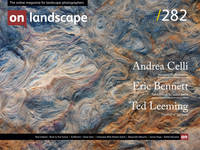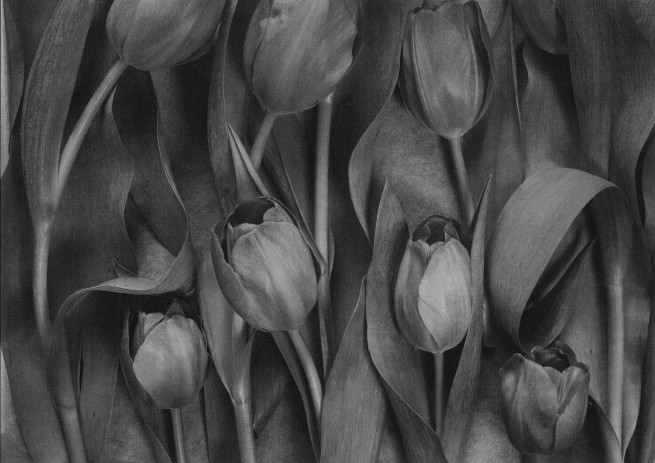George Bull discusses one of his favourite images

George Bull
When I was studying geology, I was introduced to the idea of immense periods of time and the way they could be broken down into smaller units - I suppose you might call them 'chronflakes', particles of time. The idea of chronflakes has stuck with me in my photography, with a growing awareness that a well-made photograph can freeze, compress or expand a moment in time.
I first met John Blakemore when he led a course at the wonderful Inversnaid Photography Centre (sadly now closed) near Loch Lomond. Described by Fay Godwin as a ‘celebrated fine art photographer, teacher and workshop guru’, my week with John reinvigorated my photography, giving me the courage to identify and develop possibilities that I hardly knew existed and the confidence to regain my own photographic path.
The picture I have chosen is a part of John Blakemore’s tulip journey called ‘Tulip Celebrations - 4’. Before I explain my choice of photograph, allow me to say a little about John’s approach to photography, drawing on his own words.
Having previously perceived his landscape photography as being about discovery, about recognising the significance of something that existed before he directed his attention to it, John’s tulip journey marked a transition to still-life photography and to what John calls ‘thinking photography’. Familiar spaces tend to become invisible, so photographing them is a process of rediscovery and reinvention. By accident of season, a bowl of tulips presented itself. As he continued to photograph, the tulips became a dominant motif which continued intensely for nine years until the 1994 publication of The Stilled Gaze, a monograph of tulip photographs.
There is much to commend John’s distrust of the deceptive ease of photography – the magic box, the brief moment of exposure, the lack of any necessary connection with what is to be photographed beyond the hope that it might make a good picture. I am sure that many of us have fretted about this when we are planning a day’s shooting, when we are out on location and when we are back in our workrooms.
In his landscape work, John Blakemore’s process of picture-making is supported by a tripod of three Rs: Relationship (between photographer and subject); Recognition (the moment of exposure); and Realisation (creation of the print). Something that many of us have lost in the digital era is the painful discipline of capturing what we saw in our mind’s eye just as we pressed the shutter and converting this into a vibrant, tactile print that conveys that vision to those around us. To curtail the process at an on-screen digital image is to shorten one of the key legs of the tripod.
It may be helpful to explore the tripod legs in a little more detail.
First, relationship. This is crucial – it recognises the necessity of a prolonged and intense scrutiny of place and of the resultant images. The process of developing a relationship with the subject is an essential part of picture-making. Any subject allows a diversity of responses and picture-making strategies that will express and communicate different concerns.
Relationship is both perceptual and conceptual, just as in the English language, ‘I see’ may mean both literally seeing something and also understanding it. As photographers, we must therefore develop an understanding both of our subject and of the photographic means that we use to realise it. John Blakemore’s landscape work grew out of intimacy with place, using familiarity with small-scale elements to allude to larger forces that shape the total landscape.
Next, recognition. As photographers, we are surrounded by potential subjects. What to photograph? And when to photograph? At the moment of exposure, this dilemma is temporarily suspended. The moment becomes a ‘yes’, an affirmation and recognition of the significance of an aspect of reality that will appear in the photograph.
Finally, realisation. By contrast with relationship and recognition, the process of realisation must be retrospective. For John Blakemore, realisation takes place in the darkroom, resulting in the production of silver prints. For many of us, that process now takes place on a screen and through a printer; the technology may be different, but the challenges remain the same.
So why does this particular image, with all its depth and complexity, mean so much to me? The answer lies at the nexus between John Blakemore’s mastery of landscape and of still-life photography.
As landscape photographers, we are all familiar with preparing to visit a location, having a clear notion of the elements that we wish to include in an image. Landscape being landscape, when we are out in the field, careful preparation can quickly become a process of chasing the light, seeking versions of Cartier-Bresson’s ‘decisive moment’. We may have a clear picture of what we are hoping to capture in the moment of exposure, but no matter how carefully we have prepared we are fundamentally at the mercy of the elements. That lack of control can be exhilarating, stimulating, frustrating or downright disappointing.
By contrast, in studio work the photographer has complete control over all the elements within the image, the way they are presented, how they interact and how they are lit. Each element must pass the ‘so what?’ test. If it doesn’t contribute to the photographer’s vision, then the element must be moved or removed. Compositional disciplines learned in the studio readily translate to better landscape photographs.
Then there’s lighting. Uncontrollable by the photographer working outdoors, in a studio setting – which may require no more than soft daylight coming through a window – the photographer can learn valuable lessons about shape and texture, tonal value and range, shadows and highlights. Lessons learned indoors translate well into skills required for successful outdoor work in conditions where optimum lighting may be fleeting.
For those concerned that all of this sounds very technique-driven, have no fear. Comprehending the three Rs – embracing ‘thinking photography’ to use John’s words – allows all of us to work with greater confidence to define our vision, to capture the image and to present it in a way which satisfies photographer and viewer alike.
John Blakemore Exhibition
John Blakemore: Seduced by Light brings together black and white landscapes and unique artist books to explore movement and light. The exhibition is accompanied by a new film about the photographer commissioned by the Centre for British Photography. Find the full 30 minute film on Vimeo.
The exhibition runs up to 24th September at the Centre for British Photography.
Centre for British Photography
49 Jermyn Street,
London,
SW1Y 6LX
JOHN BLAKEMORE MOVIE LONG VERSION from James Hyman on Vimeo.


